Recent Articles
-
Christmas Sword Buying Guide 2025
Dec 03, 25 10:53 PM
Cold Steels Shamshir Reviewed
The Shamshir is a Persian weapon (in Farsi, it is translated as 'sword') that came to prominence from the 13th to the 16th centuries, and has been immortalized in film many times as the sword used by the Saracens against Knights on the first holy crusade.
As usual Hollywood will not let the facts get in the way of a good story, as in reality the Saracens had straight blades much like the crusaders swords, and that the Shamshir only came to prominence after seeing how effective the cutting swords of the Mongol invaders proved to be, and thus inspired, created their own version.
And they did an excellent job..
Despite being so effective at what they are designed to do, there are only two companies in our target sub US$300 price range making a functional replica of any note: Windlass Steelcrafts of India (reviewed here) and Cold Steel.
In this hands on review, we will be taking a close look at Cold Steels offering - the Shamshir model 88STS. But as you will soon see, it would appear that the difference between these two Persian Shamshir is really only skin deep...

Cold Steel Shamshir
Review by Paul Southren (Ed), Adelaide, AUSTRALIA
|
Steel |
1065 Carbon Steel |
The Cold Steel 88STS really is a thing of beauty. With deep brass fittings, a black handle and scabbard - the color scheme is simplistic, yet the combination actually works extremely well.
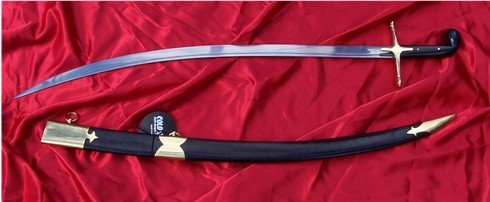
But despite being obviously attractive, I had a few concerns, starting - appropriately enough - with the hilt, or more
specifically - the pommel...
Supposedly made of black 'faux buffalo horn' (whatever that means - could be 'heavy duty plastic', though elsewhere I have seen it listed as wood) I was concerned that its somewhat sleek design, terminating in a large bulbous knob may be difficult to hold when in use. Especially if the hands get a bit sweaty...
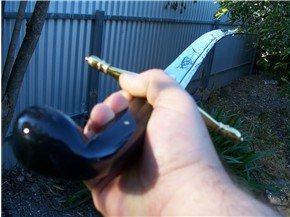
And it is true that when swinging this sword, the hand does tend to slip down the handle.
But the 'pommel' for want of a better word arrests any further movement, and after some initial trepidation I soon felt that the grip was surprisingly secure, comfortable and even snug.
Especially when held in a handshake grip - which is, from my understanding, the optimal way to wield a Shamshir.
Unfortunately, the actual construction of the hilt remains unknown and I cannot say for sure what it is made from.
A close examination reveals that it has actually been painted black - but I could not determine the original color underneath. As there was no way to access the inside of the hilt without destroying it - being neither peened nor screwed on but rather pinned much like a Katana and glued...
Everything is very tightly assembled however, with no looseness or undue movement anywhere in the assembly.
Moving on - the cross guard of the Cold Steel Shamshir is less elegant and more simplistic than the Windlass version, though essentially it is the same basic design. The two brass arms are the same, terminating in delicate and attractive looking oval shaped lobes while the top and bottom of the cross guard stretch out to form what looks something like a 4 pointed star - which in the Windlass version is overlaid with a secondary star pattern.
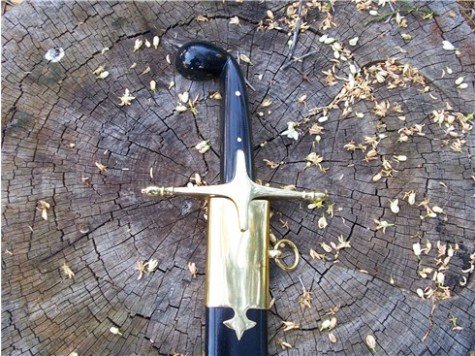
Also as a point of difference from the Windlass version, there is no seating in the mouth of the scabbard for this lower protrusion, but rather it slides neatly over the top of the brass plated throat. Otherwise though, the scabbard is IDENTICAL in design with the same chape, stitching and suspension loops - the only difference being that the Windlass Scimitars are all nickel plated while the Cold Steel model is brass.
THE BLADE
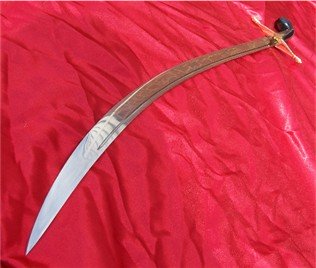
Lightweight and curvaceous is perhaps the most apt description of this fine 1lb 13oz sword.
Lightweight in part because of the perfect fuller that follows parallel to the spine, carefully following the contour before terminating some 5" from an acute and deadly looking tip.
And curvaceous - I think the image here pretty much speaks for itself.
All in all, it really is very nicely done.
The first half of the blade is almost straight. However it starts to rapidly curl somewhere towards the middle for around 5" to create the distinctive wicked curve.
I had a little trouble finding the center of percussion/primary node on the blade, mostly because the blade is really quite stiff, but as you will see from the cutting tests, the 'sweet spot' and best part to cut with the blade is at the apex of the curve, which kind of makes sense...
With a beautiful satin finish on what appears to be a beautifully tempered - but not too flexible - 1055 carbon steel blade, it was close to perfection. But there was one thing that bothered me - and that was the secondary bevel of the edge, which had obviously been added after the sword was shaped...
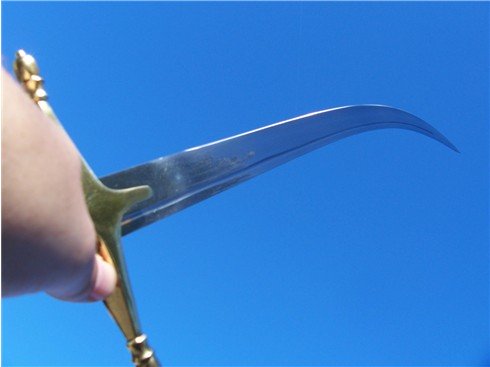
Now there was no doubt that it certainly felt sharp to the touch. And in the accompanying Cold Steel sword inspection sheet, it was noted and signed off that: "The blades must be razor sharp. If the sword does not cut the Cold Steel Stationary, it must be sent back to the polisher/sharpener for rework".
And truth be told, the geometry of a Shamshir would make them great cutters even with only the most minimal edge.
However, being the kind of person I am - and before doing any tests - I took this blade to a sheet of paper to verify for myself...
VIDEO: Cutting Paper
Nice easy cuts on a sheet of paper...
Yep! It was sharp...!
But there was something about the way the secondary bevel itself, the similarities in the cross guard and practically identical scabbard, (not to mention the excellent temper of the blade) that led me to look for more clues that the Cold Steel's Shamshir and Windlass's Scimitar were essentially the same thing....
THE WINDLASS CONNECTION...
There have been persistent rumors that Windlass Steelcrafts makes several sabers and the Shamshir for Cold steel to their specifications.
It is no secret that these particular swords are made in India. Indeed, the inspection sheet was signed off by a Mr. Keshav Verma. And the similarity of designs seemed to be more than just coincidence.
But there was one more, almost invisible detail on the blade that I found only by really looking for it. Not to mention, I also got very lucky that someone hadn't quite erased a tell tale sign...
Down towards the hilt I discovered some extremely faint writing, writing that was obviously intended to be polished off - but while faint, and extremely difficult to photograph - perhaps you can see it too...
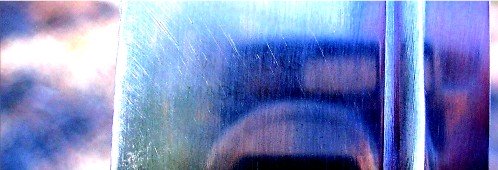
Can you see it? It is extremely hard to photograph - but it was the smoking gun I was looking for... Before it had been polished away, it was obvious that this bare blade had said 'Windlass, Made in India!'.
Yup, it seems that the rumours were now confirmed!
Now before anyone gets too excited, this should come as no shock. Windlass have some pretty good technology and make some beautifully tempered blades, so indeed - it makes sense that Cold Steel would use them to create their Indian made products. (I should even note that I found this as a reassurance that the Shamshir were made by Windlass and not another less known Indian forge - some of them make some pretty crappy stuff).
But I consider myself pretty lucky to have received a sword that solved this puzzle!
TESTING
Knowing now who had made these swords, as well as taking stock of this swords geometry and the keenness of the edge, I was quietly confident that it would be a very rewarding cutter. But before any test cutting was to be performed, I was curious as to how these could be used for an effective thrust.
In the Cold Steel Shamshir blurb they allude to this, saying that "contrary to popular belief, it was very effective at delivering rising, descending and hooking style thrusts!"
Well, I had to put it to the test!
Obviously, with such a pronounced curve, a straight thrust was out of the question. So I tried a few various combinations, settling on a flicking and curving inside hooking thrust that - despite seemingly not having a huge amount of force behind it - allowed the frighteningly sharp point surprising penetration on a cardboard box...
VIDEO: Shamshir Thust Tests
While it was difficult to generate a large amount of force, the geometry and sharpness of the sword would deliver a rather distracting and painful thrust
I was quite impressed. The curve of the Shamshir opens up several new angles of attack, and even after a few goes it was clear to me that they could be incorporated into a fighting style to deliver fast and unexpected attacks from unfamiliar angles, followed by a cut.
So now, it was time to see how effective that cut would be...
For my first targets, it was necessary to see if the secondary bevelled edge was sharpened well enough to cut some small to medium sized water filled plastic Coke bottles. Because from my own experience, if the geometry is wrong - they don't cut, they just get batted around...
My first tests were on buddy bottles, suspended from the clothesline... Something I have done many times before, though generally only with Katana...
Perhaps because of this, I misjudged my cuts slightly...
Sure, they cut through the bottles very smoothly. But if you look at the video below, you can see that my first cut didn't just sever the bottles...
VIDEO: Shamshir vs Coke Bottles
You might notice that the blade didn't just cut the bottles...Lol
I honestly didn't notice what had happened until my wife came outside a little later and said "You cut the clothesline"! But hey - at least we know that it can cut wire and a bottle in one hit now, and so smoothly, it doesn't register (though my wife did not care much for my discovery!)... ;-)
Naturally I was secretly impressed by how well these swords had performed. They had slashes the light targets to pieces without any troubles.
But the real test of a cutting optimized sword is tatami mats, the same kind used to test another popular curved sword, the Japanese Katana...
Taking several high quality half mats and preparing them in the traditional manner, I had a feeling that the Shamshir's blade would cut without too much of a problem. The only thing that concerned me ever so slightly was that they were one handed swords while the Katana was a two hander...
However, my first cut sailed on through without a problem . And I began to enjoy myself as I stalked the target and proceeded to slice and dice it from various angles, each time slicing clean through.
Indeed, this sword handled the cutting so well, the tatami was barely even registering as a target...
Deciding that the only way to truly test this swords mettle was with a somewhat more challenging target - though not too challenging as the blade is only around 1.25" inches at its most narrow (though backed up by a reasonably beefy spine of 1/4") - I gave it a target that would test the integrity of the assembly, as well as the temper and beveled edge in one go...
VIDEO: Shamshir vs Tatami and more...
Now THAT is what I call a sharp sword!
As you can see, the final target - a 3" diameter thick tree limb, was severed easily in two places from a single stroke with no transference of shock into my hands or jarring. It was clear that even these replica swords were sharp and sturdy enough to handle a wide variety of targets without sustaining even the smallest amount of damage, and the blade largely looked the same as when I first started the exercises, with only the barest of scratches.
To say I was impressed is an understatement...
CONCLUSION
If I had bought this for the US$379.99 Cold Steel advertises these for, I would definitely be recommending the Windlass Steelcrafts version. After all, while the sharpening is good - the sword IS the same as the Windlass Shamshir - and $165 is a bit rich for sharpening and brass fittings...
However, as I bought it for US$209.99 at Trueswords.com, (which is LESS than the Windlass piece), I think that the decision as to which one to get is quite an easy one.
The Windlass version is more traditional and slightly more ornate. But
the mean black and brass Cold Steel sword is a real user sword - not to
mention it is a very enjoyable sword, both from the perspective of its
uniqueness, its utility and its deadly beauty.
PROS
- Exceptional handling
- Beautifully tempered and durable blade
- Razor sharp and good to cut with straight out of the box
- Solidly assembled fittings
- Somewhat 'modern' interpretive look and feel
WHERE TO BUY
As I mentioned, the official cold steel price of $349 is a bit rich. And Trueswords no longer actually stocks Cold Steel products anymore (I bought this sword back in 2007) - so the best choice for quality and price would have to be HERE at Kult of Athena where they are available for $218.95 - which is only around $10 more than I paid back in 2007!
I hope this review of Cold Steel Shamshir has been helpful. To return to Slicers, Scimitars and Choppers from Cold Steels Shamshir Reviewed, click here

Buying Swords Online Can Be DANGEROUS!
Find the Best Swords in the:
Popular & Recommended ARTICLES

The ONLY true free online magazine for sword enthusiasts. Delivered once a month on the 1st day of the month, no filler and no BS, just the latest sword news & info delivered straight to your inbox.












